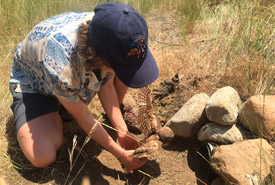The hills are alive at Sage and Sparrow
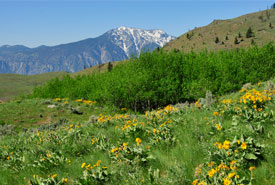
Sage and Sparrow Conservation Area (Photo by NCC)
If working as an intern at the Nature Conservancy of Canada (NCC) for the past summer has taught me anything, it’s that British Columbia encompasses lands far more varied and ecosystems more complex than I had ever imagined. Though I’ve travelled across the province (and country) before this job and felt I had a good enough sense of it, I’ve since realized how spending most of my life on coastal Vancouver Island has skewed me toward lush, green and everything salty, rocky and kelp-clad.
Given the chance to journey far from NCC’s Victoria office and into the southern interior of the province to witness and document the banding of baby burrowing owls, I immersed myself in something else entirely.
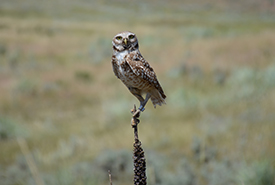
Burrowing owl on Sage and Sparrow Conservation Area (Photo by NCC)
Located near Osoyoos, just above the American border, Sage and Sparrow Conservation Area is a land totally apart from the coastline where I grew up. Unlike the relentless, rifling winds and tugging breezes of Victoria, the air in the Southern Interior feels heavy and soft. Stepping into it is like sinking into a warm bath; the rush of heat clings to the skin and seems to fold around my body like a protective force.
Sage and Sparrow Conservation Area is a huge swath of land encompassing four projects (Sagebrush Slopes, Sparrow Grasslands, South Block and Kit Carr), which together total 3,440 acres (1,390 hectares) of rare grassland habitat. Its home to a range of grassland species, from bats to western rattlesnakes and endangered sage thrasher.
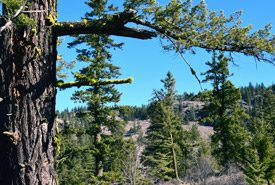
Kit Carr, Sage and Sparrow Conservation Area (Photo by NCC)
Barb Pryce, director of NCC’s Southern Interior program, drives my colleague Lesley and me to the area in her pickup truck, allowing me the luxury of sitting back and ogling the landscape out the window. The road into the conservation area is rocky, but the hills themselves are soft — in both colour and texture. Sagebrush blankets the slopes in humble pastels of tan, yellow and, of course, sage.
When we get out of the truck, the smell of sage wafts around us on warm sheets of air. The plants themselves are fuzzy and a silvery light green; their pale colour helps reflect the sun and protect them from its heat, Barb explains.
Barb points out the sagebrush/bluebunch wheatgrass which, together with silky lupine, create habitat for the half-moon hairstreak butterfly. The official species at risk registry defines the half-moon hairstreak as “a small, drab butterfly,” and although we don’t spot one, a quick Google search later reveals that they’re silver-winged and fuzzy. Just because they’re not striking and flashy doesn’t mean they aren’t their own kind of quiet marvel.
Farther down the valley in a canyon, Barb points out the area near where biologists have identified the presence of canyon bats — a species found nowhere else in Canada — which, at their biggest, weigh about the same as a quarter or a Hershey’s Kiss, and are easily mistaken for moths.
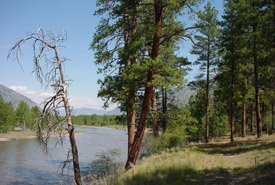
Similkameen River Pines, South Okanagan (Photo by TLC)
The hills roll out from under our feet in yellows and greens, fading to dusty blue in the distance. The Similkameen River wends its way across the American border that hovers nearby. Though there are some trees, the land is covered mostly in grasses or bushes that reveal the physicality and undulating form of the hills.
My body might not be quite as well-adapted to the climate here as the sage or the half-moon hairstreak, and after a few hours in the direct noon-day sun, I’m ready for a couple litres of water, a blast of air conditioning, a jump in the lake and, ideally, gelato.
Still, the rolling hills and valleys offer their own comfort. In the weeks since the trip, I find myself drawn to every sage-coloured thing, and brushing up against stray shrubs back home to see if they match the softness of those on Sage and Sparrow.
Now when dusk falls on the coast, I'm brought back to the Okanagan, its sky dip-dyed in shades of pink and blue and its evening air finally cool enough to make me want to waltz through the hills, humming.
Sage and Sparrow is one of the Nature Conservancy of Canada’s properties featured in Nature Destinations, a program that invites you to take a journey through some of the greatest examples of our country’s natural areas and to connect with nature. Visit naturedestinations.ca.

